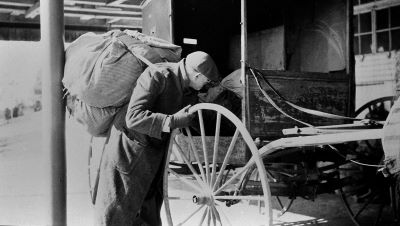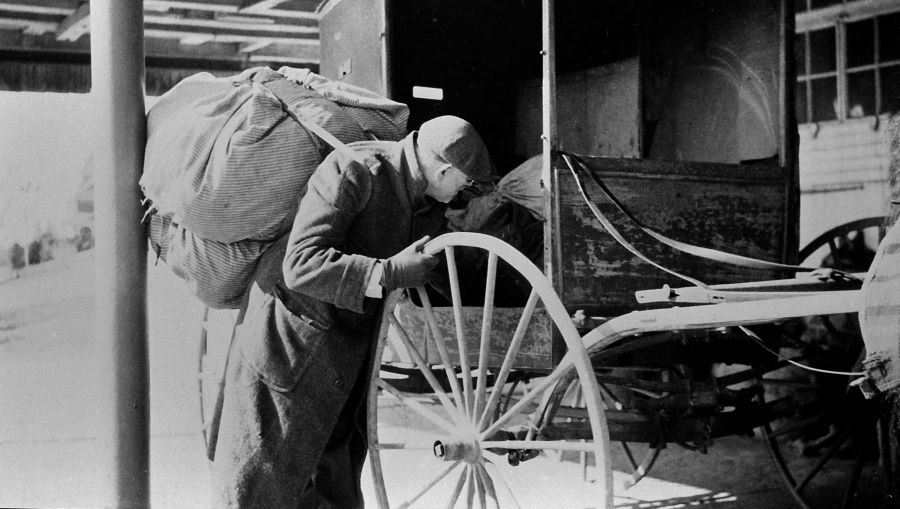Branch Valley Characters (Part 2)
Written by Joel Alderfer on June 4, 2020

Traditionally, many communities have unusual personalities, or characters, who are remembered and immortalized by stories that are passed down long after their passing. They are people whose colorful lives may not be well documented in written history, but are often remembered in the oral tradition.
I wrote these bios for the MHEP Newsletter in 1995, based on stories collected from older folks, local historians, and my own research. We’re sharing them here in two parts (this week and next), adding a couple stories written by Mary Jane Hershey.
The Branch Creek Valley follows the East Branch of the Perkiomen Creek from Perkasie to Schwenksville. More narrowly, “Branch Valley” refers to the northeast corner of Lower Salford Township, where the Indian Creek (which drains the Indian Valley) flows into the Branch. These stories are drawn from that neighborhood.
Itinerant penman Martin Wetzler
Not much is known about the life of Jewish artist Martin Wetzler, but there are numerous examples of the fraktur family records he made in Bibles, on baptismal certificates and bookplates. Based on this, we know that this itinerant scrivener worked in central Montgomery County from about 1855 to 1883. He often signed his name both in English and Hebrew, and used a Hebrew star for decoration. He apparently came from Berks County where many pieces of his work are found. As a boy, local historian Henry D. Hagey remembered Wetzler coming to the Hagey Homestead in Franconia Township, where he would sleep on the front porch bench. Hagey said Wetzler later committed suicide.


Peddler Abe Levinson
Abe Levinson was one of several itinerant Jewish peddlers who canvassed the Pennsylvania Dutch farms in Lower Salford-Franconia Township during the early 20th century. Many were German immigrants who lived in Philadelphia but found a simple livelihood among the Mennonite and Brethren farmers of the countryside.
Levinson came by horse and carriage carrying his large backpack of drygoods into the farmhouse where he would open it layer by layer, spreading the contents on the kitchen floor, attempting to make sales. Some people considered him an annoyance. He was shrewd and not always honest.
Abe would often eat dinner (noontime) at the farm he was visiting. On one occasion, he helped himself to plenty of sausage. When asked by the family if this was proper for him as a Jew, he responded, “Hecke is ken Holtz, un Wast is ken Seifleisch. [Sticks aren’t wood, and sausage isn’t pork.]” One informant remembered that he would kiss the first money he collected in the day. Levinson would sometimes get out and pull his old horse along when it walked too slow. He continued to drive his carriage on his route until he was almost blind. In about 1945, he stopped making his rounds.

Alice Reinhart, tramp lady
Reinhart was the only female tramp that local people remember. It was felt she wasn’t really a tramp because she came from a good family. She often camped out with other tramps at a wooded spot along Township Line Road in Franconia Township. Someone once found her sleeping in an open grave. When she bought something at the Franconia Square store, she paid with silver dollars because “Der anre Schtuff, es blost mel veck. [The other stuff, it blows away.]”, she said. She was killed in 1947 by a speeding automobile on Route 113 near Franconia.
Biblicists Isaac and Harvey Derstine
This father-and-son pair lived on a small farm along the Branch Creek in Lower Salford Township. They became known as religious eccentrics who tried to live a simple, almost biblical farm lifestyle, worshiping in their own home on the Sabbath. On their farm, they raised wheat, grapes, olives, figs and sheep. Isaac (1867-1939) was a member and Sunday School superintendent of the Salford Mennonite Church until the early 1900s. One Sunday morning he apparently had a disagreement with someone and never returned to Salford. His son Harvey (1899-1954) followed him, but his wife, Annie, and daughter, Emma, continued to attend Salford. Isaac was known to have heated religious discussions with his neighbors.
Isaac was free in lending money to persons in need, collecting no interest. After his own barn burned, most of the borrowers were slow in repaying their loans. Harvey was trusted by neighboring farmers to take their money to the bank for deposit. He let his hair grow long, having it cut once a year when his sheep were sheared. The sheep were allowed to come and go freely in the basement of the house.
Neighbors commented that he looked like a prophet and they recalled his limited diet of pigeons, fish, raw grain and grapes. He was the last in the township to drive a horse and wagon for religious reasons.
Harvey died mysteriously in the woods of Chester County, on a very hot day in August, while walking home from a horse auction in Lancaster County. His decayed body was found by hunters in November. It appeared he had died peacefully while lying on his back. The body was identified by his teeth and clothing.

Prophet Jonas Landis
A religious eccentric, Jonas Halteman Landis (1848-1929) last lived near Hatfield, PA, walking the roads of the Indian Valley peddling his books and proclamations. According to local historian John D. Souder, Landis had lived in Kansas for a time, where he took up claims with several other young men from Montgomery County. His mystical faith blossomed when he baptized himself by immersion. He could not find a suitable minister to perform the act, so he had a neighbor hold him in the water and Jonas performed the rite. Soon after this conversion, he returned to Pennsylvania and bought a farm near Telford, Bucks County. Because he believed in celibacy, he never married. As he grew older, he became more of an itinerant mystic, prophesying against anything that offended him.
On Sunday mornings, he would enter a church and ask permission to speak from the pulpit. He was often denied. He would go into solitary contemplation and fasting for a week or more, and emerge with a new vision and message for his travels. For a while, he was in spiritual agreement with Isaac Derstine (mentioned above) and worshiped at Derstine’s farm. In later years, he lived off the hospitality, or toleration, of relatives, friends and neighbors, inviting himself into homes and helping himself to food. One family said he liked ice cream, but wanted it heated.
Landis would give advise on most topics, whether it was desired or not. He would prophesy against such things as architectural decoration and selling milk on Sundays. When a young man from Salford built a new mechanic’s garage in Harleysville, with fancy brick work, Landis spoke against it. When the new meetinghouse was built at Salford in 1924, with its porch pillars and railings, he prophesied about that.
Locals remember he peddled a little book they called the Heart Book. Its English title was: The Heart of Man: Either A Temple of God, or A Habitation of Satan. It had graphic illustrations showing what was in a good and an evil heart.
Jonas Landis believed that a child of God would never get sick. But when he fell and dislocated his shoulder shortly before he died, he said it was because his mind was on money at the time, and not on God. He had been attempting to collect a debt owed him.
Although he was not a member of a church, he was buried in the family plot in the Salford Mennonite Cemetery. Salford preachers performed the burial.
Preacher’s wife Sallie Landis
by Mary Jane Lederach Hershey

An interesting story concerns Sallie M. Alderfer (1899-1994), who was married to preacher Elias Landis from Salford. In 1928 Enos Godshall placed Elias’s name in the lot for preacher at Salford. Although there were three others in the lot and Elias was the last to pick one of the four books, the lot fell on him. Several months after he was ordained, someone in the congregation asked Enos Godshall why he had nominated Elias, commenting, “Why he isn’t a good speaker.” Enos Godshall replied, “I knew Sallie would make a good preacher’s wife.”
She was Sallie M. Alderfer and she was indeed a dedicated minister’s wife. Elias died in 1957 when Sallie was 58 years old. She lived to be 94 years. During those 36 years, she continued her ministry, even though she had lost her role as preacher’s wife. Several years before she died, I found her in the large main foyer at Salford. This was unusual because she was almost always in the smaller front foyer. I commented to her that it was uncommon to find her in the main foyer. She spread her hands apart and said, “These are my people.” She once talked about the time “we were ordained,” very clearly understanding herself to be a part of that ordination with her husband.


